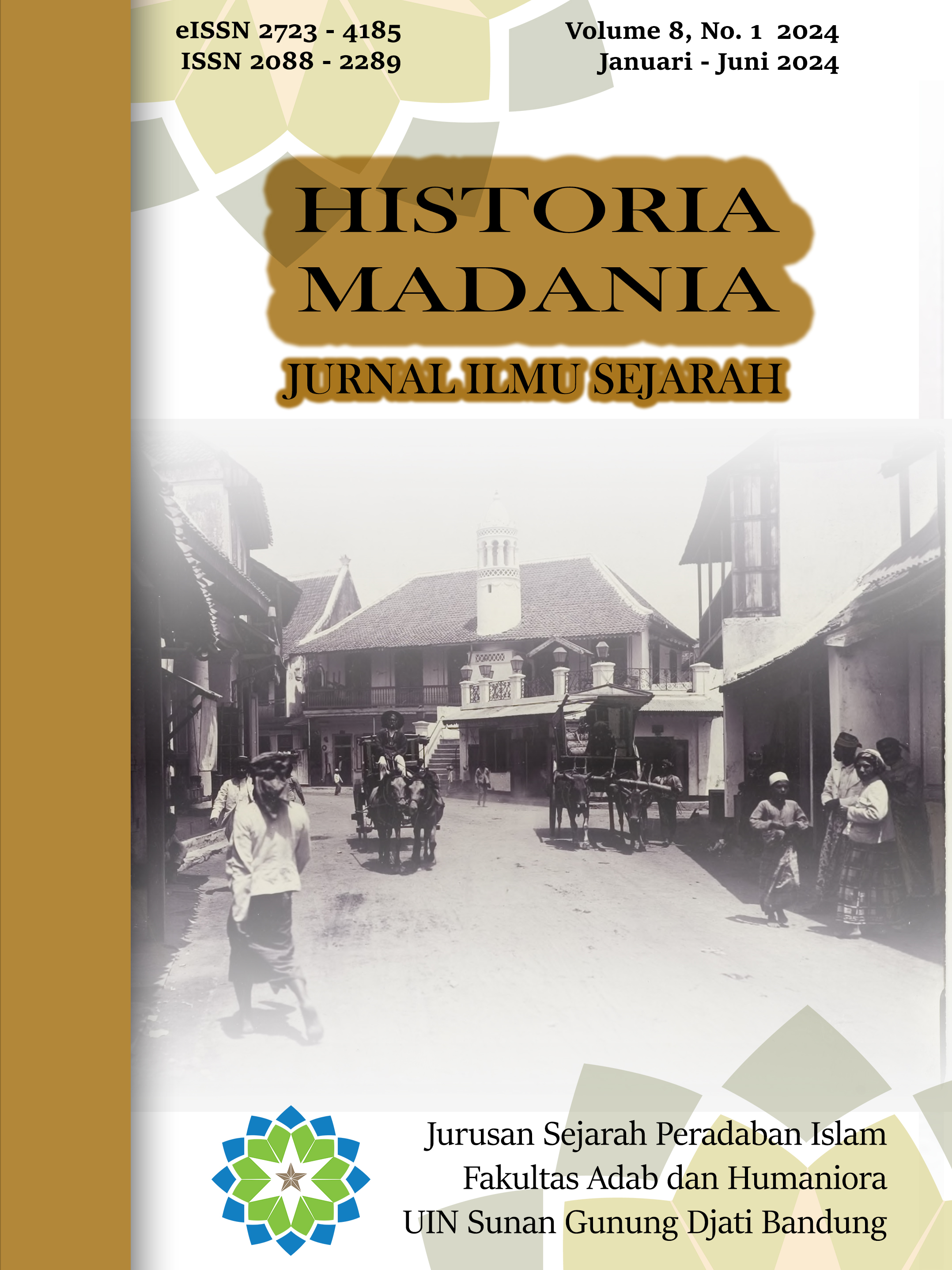The Idea of Tarikh in Syamarih fi Ilmi Tarikh by Jalal al-Din al-Suyuti
DOI:
https://doi.org/10.15575/hm.v8i1.36294Abstract
This study delves into "Syamarih fi ilmi Tarikh" by Jalaluddin al-Sayuti, an exploratory work on historical methodologies. The objective is to illuminate the essence of historical study through al-Sayuti's lens, highlighting the importance of understanding history as a discipline. Despite its profound contributions to historical discourse, al-Sayuti's text remains underexplored among scholars, signaling a gap in academic discussions on historical conceptualizations. Utilizing content analysis, this research uncovers al-Sayuti's motives and his unique approach to presenting history. Our findings indicate that al-Sayuti perceives 'tarikh' (history) as inherently linked to temporal dynamics, incorporating aspects of chronological, cyclical, and natural times. This conceptualization is closely tied to Islamic principles, suggesting that his interpretation serves not only as an academic endeavor but also as a reflection of Islamic civilization's understanding of time. Al-Sayuti's work, thus, provides insightful perspectives on the interplay between time and history, emphasizing the significance of temporal frameworks in shaping historical narratives. The conclusion underscores al-Sayuti's contribution to historical thought, offering a nuanced view that enriches our comprehension of history as both a subject and a methodology. This research affirms the critical need to further investigate such foundational texts to enhance our grasp of historical sciences.
References
“As-Suyuti, J. (1991). Syamarikh Fi Ilm Tarikh. Maktabah al-Adab.†Accessed March 7, 2024. https://ia801902.us.archive.org/1/items/Book1galerikitabkuning/book3.pdf.
“As-Suyuti, J. (2011). Tarikh al-Khulafa. Darul Kutub Islamiyah.†Accessed June 24, 2024. https://dn790009.ca.archive.org/0/items/in.ernet.dli.2015.322662/2015.322662.Tarikh-Al.pdf.
Blake, Stephen P. Time in Early Modern Islam: Calendar, Ceremony, and Chronology in the Safavid, Mughal and Ottoman Empires. Cambridge: Cambridge University Press, 2013. https://doi.org/10.1017/CBO9781139343305.
Burge, S. R. “Scattered Pearls: Exploring al-Suy.†Journal of the Royal Asiatic Society 24, no. 2 (April 2014): 251–96. https://doi.org/10.1017/S1356186313000795.
Daud, Safari. “POTRET JALALUDDIN AL-SUYUTI SEBAGAI SEORANG SEJARAWAN,†2016. https://www.semanticscholar.org/paper/POTRET-JALALUDDIN-AL-SUYUTI-SEBAGAI-SEORANG-Daud/dac1038a04a9c2abf766747de487b57646634f8a.
Donner, Fred M. Narratives of Islamic Origins: The Beginnings of Islamic Historical Writing. Gerlach Press, 2021. https://doi.org/10.2307/j.ctv1b9f5gk.
“Encyclopaedia of Islam, Second Edition — Brill.†Accessed June 24, 2024. https://referenceworks.brillonline.com/browse/encyclopaedia-of-islam-2/.
Gustafson, W. Norman. “Content Analysis in the History Class.†The Social Studies 89, no. 1 (January 1998): 39–44. https://doi.org/10.1080/00377999809599821.
Hernandez, Rebecca. The Legal Thought of Jalal Al-Din al-Suyuti: Authority and Legacy. Oxford University Press, 2017. https://doi.org/10.1093/oso/9780198805939.001.0001.
Hernandez, Rebecca Skreslet. “Introduction.†In The Legal Thought of Jalal Al-Din al-Suyuti: Authority and Legacy, edited by Rebecca Hernandez, 0. Oxford University Press, 2017. https://doi.org/10.1093/oso/9780198805939.003.0001.
Humphreys, R.S. “Historical Thought and Historiography: Islamic Tradition.†In International Encyclopedia of the Social & Behavioral Sciences: Second Edition, 61–66, 2015. https://doi.org/10.1016/B978-0-08-097086-8.62031-7.
Ibrahim al-Iji, Muhammad ibn. “Tuhfat al Fakir Ila Sahib As-Sarir Fi Ilm Tarikh,†n.d.
“JalÄl Al-DÄ«n al-SuyÅ«á¹Ä«. Volume I : Biography and Background | E.M. Sartain | Download on Z-Library.†Accessed March 7, 2024. https://z-library.se/book/1193884/8fe7a7/jal%C4%81l-ald%C4%ABn-alsuy%C5%AB%E1%B9%AD%C4%AB-volume-i-biography-and-background.html.
Kafiyaji, M. A. A. M. B. S. B. M. Mukhtasarfi Ilmi Tarikh. Alamul Kutub, 1990.
Kamaruzaman, Azmul Fahimi, Norsaeidah Jamaludin, and Ahmad Faathin Mohd Fadzil. “Ibn Al-Athir’s Philosophy of History in Al-Kamil Fi Al-Tarikh.†Asian Social Science 11, no. 23 (September 17, 2015): p28. https://doi.org/10.5539/ass.v11n23p28.
Krippendorff, Klaus. Content Analysis: An Introduction to Its Methodology. SAGE, 2013.
Marsh, Wendell. “Reading with the Colonial in the Life of Shaykh Musa Kamara, a Muslim Scholar-Saint,†May 2020, 604–24. https://doi.org/10.1017/S0001972020000091.
Nurcahya, Nurcahya, and Mahbub Hefdzil Akbar. “Pemikiran Muhammad bin Sulaiman bin Saad Al-Kafiyaji dalam Bidang Sejarah: Studi Historiografi dan Filologi Terhadap Kitab Al-Mukhtas A-R Al-Mufid Fi Ilmi Al-Tarikh Abad ke-15 M.†Historia Madania: Jurnal Ilmu Sejarah 3, no. 2 (December 28, 2019): 121–46. https://doi.org/10.15575/hm.v3i2.9172.
“Reflections on Periodisation in Aradic Historiography - Tarif Khalidi, 1998.†Accessed June 24, 2024. https://journals.sagepub.com/doi/10.1177/097194589800100107.
Rosenthal, Franz. “A History of Muslim Historiography /.†Leiden : E. J. Brill, 1968.
Schreier, Margrit. Qualitative Content Analysis in Practice. 1 Oliver’s Yard, 55 City Road London EC1Y 1SP: SAGE Publications Ltd, 2012. https://doi.org/10.4135/9781529682571.
“The History of Time: A Very Short Introduction - Leofranc Holford-Strevens - Oxford University Press.†Accessed June 25, 2024. https://global.oup.com/academic/product/the-history-of-time-a-very-short-introduction-9780192804990?cc=id&lang=en&.
Topal, Ahmet. “The Narrative Change in Muslim Historiography within the Context of the Expedition to Al-KharrÄrHarrÄr Seriyyesi Özelinde Müslüman Tarih Yazıcılığında Anlatı DeÄŸiÅŸimi.†Türkiye Ä°lahiyat AraÅŸtırmaları Dergisi 7 (March 27, 2023). https://doi.org/10.32711/tiad.1233329.
Wildan, T., and Ismail Fahmi Arrauf Nasution. “JALÂL AL-DÎN AL-MAHALLÎ AND JALÂL AL-DÎN AL-SUYUTÎS’ INTERPRETATION METHOD OF THE MUTASYÂBIHÂT VERSE IN TAFSÎR JALÂLAYN.†MIQOT: Jurnal Ilmu-Ilmu Keislaman 46, no. 1 (August 29, 2022): 1–25. https://doi.org/10.30821/miqot.v46i1.882.
Wilschut, Arie. “Historical Consciousness of Time and Its Societal Uses.†Journal of Curriculum Studies 51, no. 6 (November 2, 2019): 831–49. https://doi.org/10.1080/00220272.2019.1652939.
Downloads
Published
How to Cite
Issue
Section
Citation Check
License
Authors who publish with this journal agree to the following terms:
- Authors retain copyright and grant the journal right of first publication with the work simultaneously licensed under a Creative Commons Attribution License that allows others to share the work with an acknowledgment of the work's authorship and initial publication in this journal.
- Authors are able to enter into separate, additional contractual arrangements for the non-exclusive distribution of the journal's published version of the work (e.g., post it to an institutional repository or publish it in a book), with an acknowledgment of its initial publication in this journal.
- Authors are permitted and encouraged to post their work online (e.g., in institutional repositories or on their website) prior to and during the submission process, as it can lead to productive exchanges, as well as earlier and greater citation of published work (See The Effect of Open Access).


